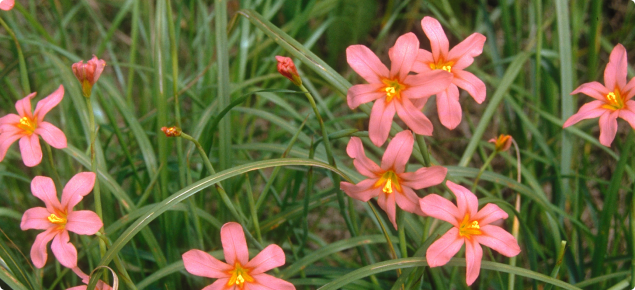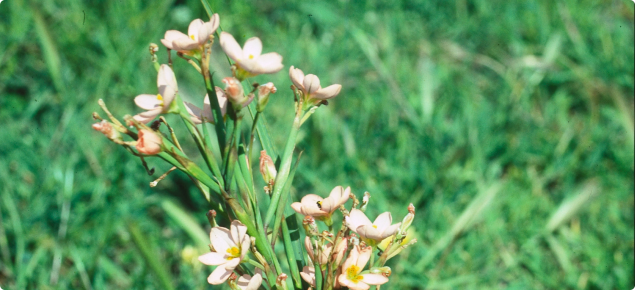What you need to know about Cape tulip
Cape tulip is the common name applied to two toxic plants native to South Africa. These are the one-leaf Cape tulip (Moraea flaccida, formerly known as Homeria flaccida) and the two-leaf Cape tulip (M. miniata, formerly known as H. miniata).
Like many other serious weeds, Cape tulips were introduced to Australia as garden plants because of their attractive flowers and hardy nature.
They soon jumped the garden fence and now both are common and widespread in the south-west of Western Australia (WA) and are weeds in South Australia, Victoria and New South Wales. One-leaf Cape tulip is also found in Tasmania and New Zealand. Five Moraea species including M. flaccida and M. miniata are on the US Federal Noxious Weeds list.
Cape tulips are members of the iris family, Iridaceae, a large family with both native and exotic species in WA. Examples of other weedy species are freesia (Freesia hybrid), some gladiolus (for example, Gladiolus caryophyllaceus and G. undulatus) and watsonias (Watsonia spp.) which are all native to South Africa.
One-leaf and two-leaf Cape tulip are declared plants in WA and their import is regulated. Several other Moraea species have been found in WA and it would be wise to regard all Moraea species as toxic.
Why Cape tulip matters
Both one-leaf and two-leaf Cape tulips are serious weeds of pasture. Animals will selectively graze clovers and other more palatable species, and this allows Cape tulips to flourish. They contain toxic chemicals called glycosides which affect the heart.
Symptoms of poisoning in cattle include loss of appetite, abdominal pain, stiffness of the hind legs, diarrhoea, general depression, and weakness that may advance to convulsions or paralysis. Death may occur within hours of consuming the plant, or over several days. At post-mortem examination there is usually evidence of gastro-enteritis, with reddening of the abomasum (true stomach), and longitudinal red striping of the caecum and terminal large bowel. The heart may show haemorrhages on the inside and outside surfaces.
Cattle are most commonly affected, and poisoning usually occurs when stock unaccustomed to the plant are placed on heavily infested pastures. About a kilogram of fresh leaf material is enough to cause death overnight.
Sheep are rarely affected, although they are susceptible to the toxins. Placing very hungry sheep on infested green or dry pasture may result in poisoning.
The plant remains toxic even when dry, so contaminated hay can also be a problem. There is no treatment readily available. Prevent poisoning by avoiding contact with the plants. Always seek veterinary advice when livestock show unusual symptoms and/or unexplained deaths occur.
Cape tulip can be difficult and expensive to eradicate. Some herbicides effective in controlling Cape tulip also damage pasture legumes. Research is continuing into economically viable means of control, including biological control.
Online weed identification training
Login or set up a new account on DAFWAs online training site to access:
- a training course on how to identify Cape tulip and report it.
- training material that you can use to teach community groups how to identify Cape tulip.
What you should look for
One-leaf Cape tulip, as the name suggests, typically has only one leaf per plant. The leaves are 1-2cm wide and can be up to 1m long. The erect flowering stem can reach up to 60cm in height. The flowers are usually orange to salmon pink with a yellow centre, but occasionally plain yellow. The small brown seeds are produced in a three-valved capsule up to 5cm long. The underground corm has a light brown fibrous covering.
Two-leaf Cape tulip is very similar in appearance to one-leaf, but has two or three leaves per plant. Two-leaf Cape tulip does not produce seeds but produces a large number of small cormils around the parent corm, and in the angle where the leaves join the stem. The underground corm has a hard black covering.
Life history of Cape tulips
Cape tulips prefer heavier soils, but will grow in sand. The heaviest infestations tend to be found on clay or loam in the earliest settled areas in the Swan and Avon Valleys, though infestations extend from the Geraldton area through the South-West to Esperance and the Goldfields.
Cape tulips are found on agricultural land (especially permanent pastures), roadsides, wasteland and in remnant bushland. The corms and cormils are spread by cultivation, and by earthworks such as road grading. They do not usually invade waterlogged sites, though both species can survive periodic inundation. Cape tulip corms and cormils can be spread by floodwaters.
Both seeds and corms of one-leaf Cape tulip emerge in autumn after rain. Depending on the season, up to 60% of corms can remain dormant in the soil. Dense infestations can have almost 7000 corms per square metre. Flowering takes place in spring. Plants do not flower until they are two or three years old.
Two-leaf Cape tulip has a similar life cycle, emerging in autumn and flowering in spring. Two-leaf Cape tulip does not produce seeds but produces cormils on the stem. In dense infestations there can be up to 700 000 cormils per square metre. Cormils can remain dormant for up to eight years.
What you can do
The dormancy associated with both Cape tulip species can lead to disappointment with control efforts. If a good kill is achieved in a year when many plants are dormant, there may be many more plants present the following season. Ask your agribusiness consultant, local Biosecurity Officer or landcare coordinator for assistance in preparing a weed management plan.
Practise good biosecurity to avoid introducing Cape tulip to your property and to avoid poisoning livestock. Take particular care to buy hay that does not contain Cape tulip or other unwanted weeds. It can be an offence to sell or transport hay or other materials containing declared pests - offences can be reported to the nearest office of the Department of Agriculture and Food, Western Australia.
Do not allow contractors with dirty machinery to work on your property - if necessary provide a wash-down area so they can clean their equipment. If you already have Cape tulip, do not allow it to spread from your property. Learn and map where infestations are located to avoid spreading Cape tulip by cultivation. Include weed infestations in farm mapping and planning.
If you can, always work from clean to dirty areas. Wash down machinery before moving it to clean areas, as Cape tulip and many other weeds are known to spread in soil. Use effective control techniques, including herbicides, to reduce the size of Cape tulip infestations.
Some landholders have expressed concern about using 'toxic' chemicals on pastures; however, remember that Cape tulip can be deadly to livestock and the longer its control is delayed, the more it will spread.
When choosing plants for your garden, avoid buying species that are toxic and/or have weed potential. Mail order catalogues may be convenient but some offer toxic weeds for sale such as chincherinchee (Ornithogalum thyrsoides). If you have questions about suitable garden plants, your local landcare or catchment group may be able to provide advice.
Articles on weedy bulbs and garden plants are available on this website, or from the Pest and Disease Information Service. Accredited nurseries should also be able to provide advice.
For identification of weed specimens, please take a sample to your nearest Department of Agriculture and Food office, or post it to AGWEST Plant Laboratories.
Further reading
Moore, J and Wheeler, J 2008, Southern Weeds and their control (2nd edition). Department of Agriculture and Food.
Parsons, WT and Cuthbertson, EG 2000, Noxious Weeds of Australia. CSIRO Publishing.


